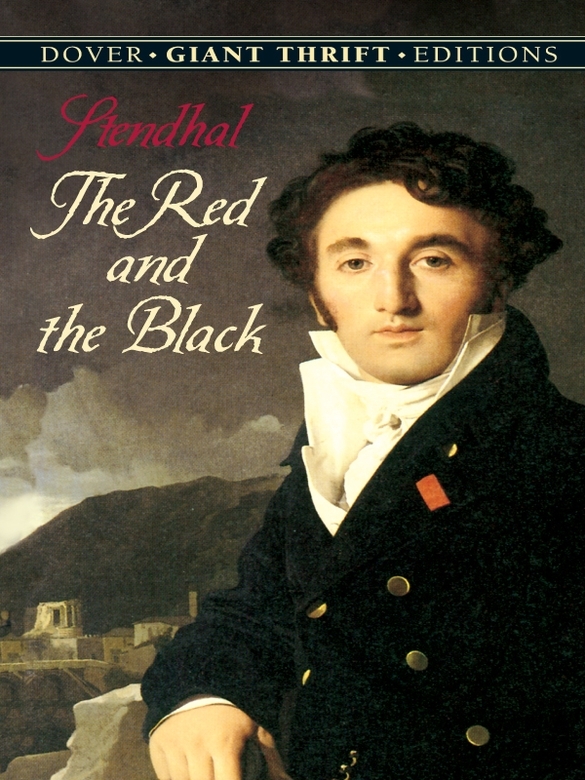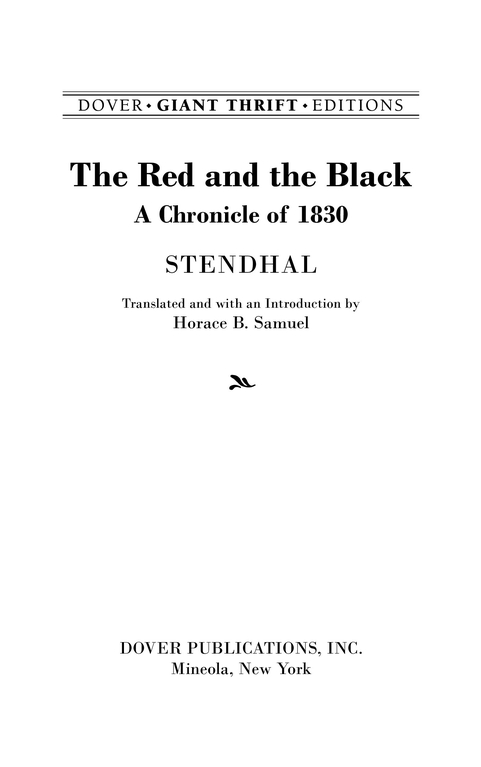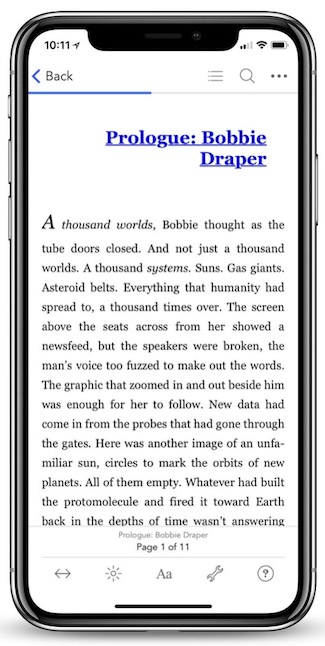The Red and the Black


DOVER GIANT THRIFT EDITIONS
GENERAL EDITOR: PAUL NEGRI
EDITOR OF THIS VOLUME: TOM CRAWFORD
Bibliographical Note
This Dover edition, first published in 2004, is an unabridged republication of The Red and the Black: A Chronicle of 1830 published by Kegan Paul, Trench, Trübner & Co., Ltd., London, 1916.
Â
Â
Library of Congress Cataloging-in-Publication Data
Stendhal, 1783â1842.
[Rouge et le noir. English]
The red and the black / Stendhal ; translated by Horace B. Samuel.
p. cm.
9780486114743
1. Samuel, Horace Barnett, 1883â II. Title.
PQ2435.R7E5 2004
843'.7âdc22
2004052695
Â
Manufactured in the United States of America
Dover Publications, Inc., 31 East 2nd Street, Mineola, N.Y. 11501
Some slight sketch of the life and character of Stendhal is particularly necessary to an understanding of Le Rouge et Le Noir (The Red and the Black) not so much as being the formal stuffing of which introductions are made, but because the book as a book stands in the most intimate relation to the author's life and character. The hero, Julien, is no doubt, viewed superficially, a cad, a scoundrel, an assassin, albeit a person who will alternate the moist eye of the sentimentalist with the ferocious grin of the beast of prey. But Stendhal so far from putting forward any excuses makes a specific point of wallowing defiantly in his own alleged wickedness. “Even assuming that Julien is a villain and that it is my portrait,” he wrote shortly after the publication of the book, “why quarrel with me. In the time of the Emperor, Julien would have passed for a very honest man. I lived in the time of the Emperor. Soâbut what does it matter?”
Henri Beyle was born in 1783 in Grenoble in Dauphiny, the son of a royalist lawyer, situated on the borderland between the gentry and that bourgeoisie which our author was subsequently to chastise with that malice peculiar to those who spring themselves from the class which they despise. The boy's character was a compound of sensibility and hard rebelliousness, virility and introspection. Orphaned of his mother at the age of seven, hated by his father and unpopular with his schoolmates, he spent the orthodox unhappy childhood of the artistic temperament. Winning a scholarship at the Ecole Polytechnique at the age of sixteen he proceeded to Paris, where with characteristic independence he refused to attend the college classes and set himself to study privately in his solitary rooms.
In 1800 the influence of his relative M. Daru procured him a commission in the French Army, and the Marengo campaign gave him an opportunity of practising that Napoleonic worship to which throughout his life he remained consistently faithful, for the operation of the philosophical materialism of the French sceptics on an essentially logical and mathematical mind soon swept away all competing claimants for his religious adoration. Almost from his childhood, moreover, he had abominated the Jesuits, and “Papism is the source of all crimes,” was throughout his life one of his favourite maxims.
After the army's triumphant entry into Milan, Beyle returned to Grenoble on furlough, whence he dashed off to Paris in pursuit of a young woman to whom he was paying some attention, resigned his commission in the army and set himself to study “with the view of becoming a great man.” It is in this period that we find the most marked development in Beyle's enthusiasm of psychology. This tendency sprang primarily no doubt from his own introspection. For throughout his life Beyle enjoyed the indisputable and at times dubious luxury of a double consciousness. He invariably carried inside his brain a psychological mirror which reflected every phrase of his emotion with scientific accuracy. And simultaneously, the critical spirit, half-genie, half-demon inside his brain, would survey in the semidetached mood of a keenly interested spectator, the actual emotion itself, applaud or condemn it as the case might be, and ticket the verdict with ample commentations in the psychological register of its own analysis.
But this trend to psychology, while as we have seen, to some extent, the natural development of mere self-analysis was also tinged with the spirit of self-preservation. With a mind, which in spite of its natural physical courage was morbidly susceptible to ridicule and was only too frequently the dupe of the fear of being duped, Stendhal would scent an enemy in every friend, and as a mere matter of self-protection set himself to penetrate the secret of every character with which he came into contact. One is also justified in taking into account an honest intellectual enthusiasm which found its vent in deciphering the rarer and more precious manuscripts of the “human document.”
With the exception of a stay in Marseilles, with his first mistress Mélanie Guilhert (“a charming actress who had the most refined sentiments and to whom I never gave a sou,”) and a subsequent sojourn in Grenoble, Stendhal remained in Paris till 1806, living so far as was permitted by the modest allowance of his niggard father the full life of the literary temperament. The essence, however, of his character was that he was at the same time a man of imagination and a man of action. We consequently find him serving in the Napoleonic campaigns of 1806, 1809 and 1812. He was present at the Battle of Jena, came several times into personal contact with Napoleon, discharged with singular efficiency the administration of the State of Brunswick, and retained his sangfroid and his bravery during the whole of the panic-stricken retreat of the Moscow campaign.
It is, moreover, to this period that we date Stendhal's liaison with Mme. Daru, the wife of his aged relative, M. Daru. This particular intrigue has, moreover, a certain psychological importance in that Mme. Daru constituted the model on whom Mathilde de la Mole was drawn in The Red and the Black. The student and historian consequently who is anxious to check how far the novelist is drawing on his experience and how far on his imagination can compare with profit the description of the Mathilde episode in The Red and the Black with those sections in Stendhal's Journal entitled the Life and Sentiments of Silencious Harry, Memoirs of my Life during my Amour with Countess Palfy, and also with the posthumous fragment, Le Consultation de Banti, a piece of methodical deliberation on the pressing question, “Dois-je ou ne dois-je pas avoir la duchesse?” written with all the documentary coldness of a Government report. It is characteristic that both Bansi and Julien decide in the affirmative as a matter of abstract principle. For they both feel that they must necessarily reproach themselves in after life if they miss so signal an opportunity.
Disgusted by the Restoration, Stendhal migrated in 1814 to Milan, his favourite town in Europe, whose rich and varied life he savoured to the full from the celebrated ices in the entreates of the opera, to the reciprocated interest of Mme. Angelina Pietragrua (the Duchesse de Sansererina of the Chartreuse of Parma), “a sublime wanton à la Lucreziz Borgia” who would appear to have deceived him systematically. It was in Milan that Stendhal first began to write for publication, producing in 1814 The Lives of Haydn and Mozart, and in 1817 a series of travel sketches, Rome, Naples, Florence, which was published in London.
It was in Milan also that Stendhal first nursed the abstract thrills of his grand passion for Mètilde Countess Dunbowska, whose angelic sweetness would seem to have served at any rate to some extent as a prototype to the character of Mme. de Rênal. In 1821 the novelist was expelled from Milan on the apparently unfounded accusation of being a French spy. It is typical of that mixture of brutal sensuality and rarefied sentimentalism which is one of the most fascinating features of Stendhal's character, that even though he had never loved more than the lady's heart, he should have remained for three years faithful to this mistress of his ideal.
In 1822 Stendhal published his treatise, De l'Amour, a practical scientific treatise on the erotic emotion by an author who possessed the unusual advantage of being at the same time an acute psychologist and a brilliant man of the world, who could test abstract theories by concrete practice and could co-ordinate what he had felt in himself and observe in others into broad general principles.
In 1825 Stendhal, plunging vigorously into the controversy between the Classicists and the Romanticists, published his celebrated pamphlet, Racine and Shakespeare, in which he vindicated with successful crispness the claims of live verse against stereotyped couplets and of modern analysis against historical tradition. His next work was the Life of Rossini, whom he had known personally in Milan, while in 1827 he published his first novel Armance, which, while not equal to the author's greatest work, give none the less good promise of that analytical dash which he was subsequently to manifest. After Armance come the well-known Promenades Rome, while the Stendhalian masterpiece Le Rouge et Le Noir was presented in 1830 to an unappreciative public.
Enthusiasm for this book is the infallible test of your true Stendhalian. Some critics may prefer, possibly, the more Jamesian delicacy of Armance, and others fortified by the example of Goethe may avow their predilection for The Chartreuse de Parme with all the jeune premier charm of its amiable hero. But in our view no book by Stendhal is capable of giving the reader such intellectual thrills as that work which has been adjudged to be his greatest by Balzac, by Taine, by Bourget. Certainly no other book by Stendhal than that which has conjured up Rougistes in all countries in Europe has been the object of a cult in itself. We doubt, morever, if there is any other modern book whether by Stendhal or any one else, which has actually been learnt by heart by its devotees, who, if we may borrow the story told by M. Paul Bourget, are accustomed to challenge the authenticity of each other's knowledge by starting off with some random passage only to find it immediately taken up, as though the book had been the very Bible itself.
The more personal appeal of what is perhaps the greatest romance of the intellect ever written lies in the character of Julien, its villain-hero. In view of the identification of Julien with Stendhal himself to which we have already alluded, it is only fair to state that Stendhal does not appear to have ever been a tutor in a bourgeois family, nor does history relate his ever having made any attempt at the homicide of a woman. So far, in fact, as what we may call the external physical basis of the story is concerned, the material is supplied not by the life of the author, but by the life of a young student of Besançon, of the name of Berthet, who duly expiated on the threshold that crime which supplied the plot of this immortal novel. But the soul, the brain of Julien is not Berthet but Beyle. And what indeed is the whole book if not a vindication of beylisme, if we may use the word, coined by the man himself for his own outlook on life? For the procedure of Stendhal would seem to have placed his own self in his hero's shoes, to have lived in imagination his whole life, and to have recorded his experience with a wealth of analytic detail, which in spite of some arrogance, is yet both honest and scientific.
And the life of this scoundrel, this ingrate, this assassin, certainly seems to have been eminently worth living. In its line, indeed, it constitutes a veritable triumph of idealism, a positive monument of “self-help.” For judged by the code of the Revolution, when the career was open to talents, the goodness or badness of a man was determined by the use he made of his opportunities. Efficiency was the supreme test of virtue, as was failure the one brand of unworthiness. And measured by these values Julien ranks high as an ethical saint. For does he not sacrifice everything to the forgiving of his character and the hammering out of his career? He is by nature nervous, he forces himself to be courageous, fighting a duel or capturing a woman, less out of thirst for blood or hunger for flesh, than because he thinks it due to his own parvenu self-respect to give himself some concrete proof of his own moral force. “Pose and affection” will sneer those enemies whom he will have to-day as assuredly as he had them in his lifetime, the smug bourgeois and Valenods of our present age. But the spirit of Julien will retort, “I made myself master of my affectation and I succeeded in my pose.” And will he not have logic on his side? For what after all is pose but the pursuit of a subjective ideal, grotesque no doubt in failure, but dignified by its success? And as M. Gaultier has shown in his book on Bovarysme, is not all human progress simply the deliberate change from what one is, into what one is not yet, but what nevertheless one has a tendency to be? Viewed from this standpoint Julien's character is what one feels justified in calling a bonâ fide pose. For speaking broadly his character is two-fold, half-sensitive tenderness, half-ferocious ambition, and his pose simply consists in the subordination of his softer qualities for the more effective realization of his harder. Considered on these lines Le Rouge et Le Noir stands preeminent in European literature as the tragedy of energy and ambition, the epic of the struggle for existence, the modern Bible of Nietzschean self-discipline. And from the sheer romantic aspect also the book has its own peculiar charm. How truly poetic, for instance, are the passages where Julien takes his own mind alone into the mountains, plots out his own fate, and symbolizes his own solitary life in the lonely circlings of a predatory hawk.
Julien's enemies will no doubt taunt him with his introspection, while they point to a character distorted, so they say, by the eternal mirror of its own consciousness. Yet it should be remembered that Julien lived in an age when introspection had, so to speak, been only recently invented, and Byronism and Wertherism were the stock food of artistic temperaments. In the case of Julien, moreover, even though his own criticisms on his own acts were to some extent as important to him as the actual acts themselves, his introspection was more a strength than a weakness and never blunted the edge of his drastic action. Compare, for instance, the character of Julien with the character of Robert Greslou, the hero of Bourget's Le Disciple, and the nearest analogue to Julien in fin de siècle literature, and one will appreciate at once the difference between health and decadence, virility and hysteria.
One of the most essential features of the book, however, is the swing of the pendulum between Julien's ambition and Julien's tenderness. For our hunter is quite frequently caught in his own traps, so that he falls genuinely in love with the woman whom, as a matter of abstract principle, he had specifically set himself to conquer. The book consequently as a romance of love, ranks almost as high as it does as a romance of ambition. The final idyll in prison with Mme. de Rênal, in particular, is one of the sweetest and purest in literature, painted in colours too true ever to be florid, steeped in a sentiment too deep ever to be mawkish. As moreover, orthodox and surburban minds tend to regard all French novels as specifically devoted to obscene wallowings, it seems only relevant to mention that Stendhal at any rate never finds in sensualism any inspiration for ecstatic rhapsodies, and that he narrates the most specific episodes in the chastest style imaginable.

